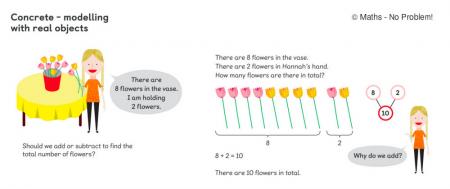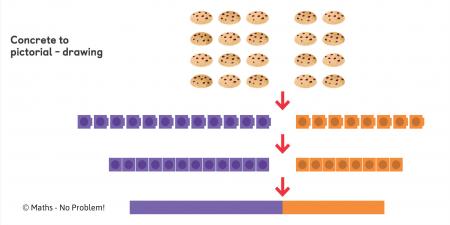Calculation Strategies Documents and Films
The documents and films on this page provide examples of the progression in the teaching and learning of calculation strategies that we follow in Bitterne Manor Primary school.
Addition strategies

Addition strategies - short and expanded methods

Subtraction methods

Multiplication methods

Division strategies

The CPA approach
Concrete > pictorial > abstract (CPA) is a key feature of the Singapore maths mastery method now being taught in many primary schools.
The CPA method involves using actual objects for children to add, subtract, multiply or divide. They then progress to using pictorial representations of the object, and ultimately, abstract symbols.
Children often find maths difficult because it is abstract. The CPA approach helps children learn new ideas and build on their existing knowledge by introducing abstract concepts in a more familiar and tangible way.
Concrete is the ‘doing’ stage, using concrete objects to solve problems. It brings concepts to life by allowing children to handle physical objects themselves. Every new abstract concept is learned first with a ‘concrete’ or physical experience. For example:
There are 8 flowers in the vase. Hannah has 2 flowers in her hand. How many flowers are there altogether?
In this problem, the children might first handle actual flowers – the concrete stage – before progressing to handling counters or cubes (like Numicon) which are used to represent the flowers.

Pictorial is the ‘seeing’ stage, using representations of the objects involved in maths problems. This stage encourages children to make a mental connection between the physical object and abstract levels of understanding, by drawing or looking at pictures, circles, diagrams or models which represent the objects in the problem.
Building or drawing a model makes it easier for children to grasp concepts they traditionally find more difficult, such as fractions, as it helps them visualise the problem and make it more accessible.
For example, for the above problem, the pictorial stage would involve using drawings of flowers, or pictures of objects such as multi-link blocks or counters, to represent the actual object.

Abstract is the ‘symbolic’ stage, where children are able to use abstract symbols to model and solve maths problems.
Once a child has demonstrated that they have a solid understanding of the ‘concrete’ and ‘pictorial’ representations of the problem, the teacher can introduce the more ‘abstract’ concept, such as mathematical symbols.
Children are introduced to the concept at a symbolic level, using only numbers, notation, and mathematical symbols, for example +, –, x, / to indicate addition, multiplication, or division.
So, for the following problem:
Jim has 12 cookies. Julie has 8 cookies. How many do they have altogether?
Children at the abstract stage would be able to solve the problem by writing it out as 12 + 8 = 20.
Although CPA has three distinct stages, a skilled teacher will go back and forth between them to reinforce concepts. They should also vary the apparatus the children use in class. For example, one day they might use counters; another day they might use a ten frame.
Similarly, children are encouraged to represent maths problems in a variety of ways, for example, drawing an array, a number bond diagram or a bar model. Varying the apparatus and methods they use to solve a problem helps children to make quicker mental connections between the concrete, pictorial and abstract phases.
At Bitterne Manor, we use a variety of resources, including multilink, Numicon, stackable counters, place value counters, Base 10 (Diennes), lollysticks, cups and a variety of every day objects.
Please see the document below for the CPA calculation policy that we are using in school.
